How to Set Priorities by Dr Milan Milanović
How to set priorities? - by Dr Milan Milanović #
Excerpt #
as an individual, as a leader or as a team.
Some people may ask why I need to set priorities, as I would work on the next thing or the things someone else tells me to do. But without setting priorities, you would not get so far and achieve any success because you would work in a chaotic mode. Setting priorities is probably the most important thing you can do to achieve your goals. Do you have goals? If not, check this first:
Setting priorities gives you multiple advantages:
✅ Clarity. Setting priorities helps you focus your effort on a manageable number of tasks. Rather than simply becoming overwhelmed by the million tasks you have to perform, you can maintain your focus and succeed by doing this. Your professional aspirations and the organization’s objectives will always be clear when you’ve established sensible priorities at work.
✅ Focus. No matter how hectic or stressful your job becomes, you’ll always know what parts of your professional life are most important when you define priorities. Setting priorities can help you stay focused and accountable for achieving your professional objectives.
✅ Reduce stress. Without prioritization, you may try to do too many things at once, make poor decisions, and constantly feel like you’re playing catch-up. Prioritizing allows you to focus on what’s most important, allocate your time and energy effectively, and achieve a better work-life balance. Failing to set priorities can result in constant stress, burnout, and a lack of focus, so it’s essential to take the time to identify and focus on your top priorities.
Various methods exist to help prioritize tasks, each suitable for different contexts and needs. Here, we’ll explore some of the most effective methods for individuals, teams, and leaders.
So, let’s dive in.
WeAreDevelopers World Congress (Sponsored) #
Don’t miss the WeAreDevelopers World Congress, where over 15,000 tech enthusiasts will gather in Berlin from July 17 to 19.
Grab your exclusive free ticket - limited to the first 20! Others enjoy 25% off using code “WWC24_techworld”.
[

1. For Individuals #
Here are a few methods you can use for prioritization in your personal productivity cycle.
1.1. Eisenhower Matrix #
This method helps you understand that urgent is not the same as important. It divides tasks into four quadrants based on urgency and importance, enabling one to focus on what truly matters.
Developed by Dwight D. Eisenhower, the 34th President of the United States, who often said, “What is important is seldom urgent, and what is urgent is seldom important.” The concept was later popularized by Stephen Covey in his book “ The 7 Habits of Highly Effective People, creating the time management matrix we know today.
So, how can you use it? When you get a task, you put it in one of the four quadrants:
Urgent and Important (Do it first). Tasks that require immediate attention and have significant consequences and probably a deadline. Examples are things that are not working, errors, things we are not sure are working correctly, and security risks.
Non-Urgent and Important (Schedule it): These tasks can be scheduled for later. Some examples are learning new stuff, fixing tech debt, etc. This is the quadrant where you want to work the most, as it gives you the critical advantage. The trick is that people usually neglect it, as it is non-urgent and usually doesn’t have a strict deadline.
🚩 One way to spend more time here is the “power hour” thing, i.e., do it the first time in the morning before checking your e-mails or doing anything else. This makes miracles!
Urgent and Non-Important (Delegate it). Tasks that need quick attention but have little impact. Some examples are answering Slack and some minor requests.
Non-Urgent and Non-Important (Eliminate it). Tasks that are distractions and can be eliminated. Some examples are unnecessary meetings that could involve emails, over-optimizing code, etc.
So, the trick is to focus on the right tasks by prioritizing essential tasks and saying NO to non-important and non-urgent ones.
The benefits of this method are:
✅ It helps you focus on what truly matters
✅ Reduces time spent on unimportant tasks
✅ Improves long-term planning and productivity
Best for: Managing a mix of personal and professional tasks with different levels of urgency and importance.
[
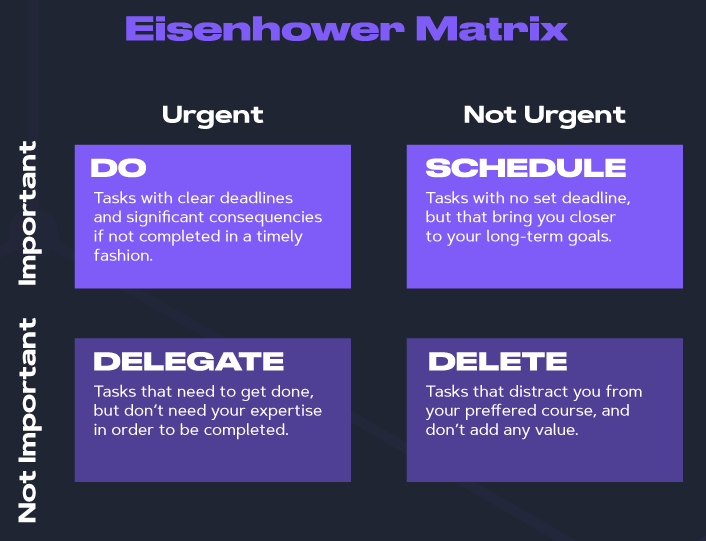
The Eisenhower Matrix
⚒️ Tools: Check my Eisenhower Matrix template in Miro below or use other tools like Todoist.
[
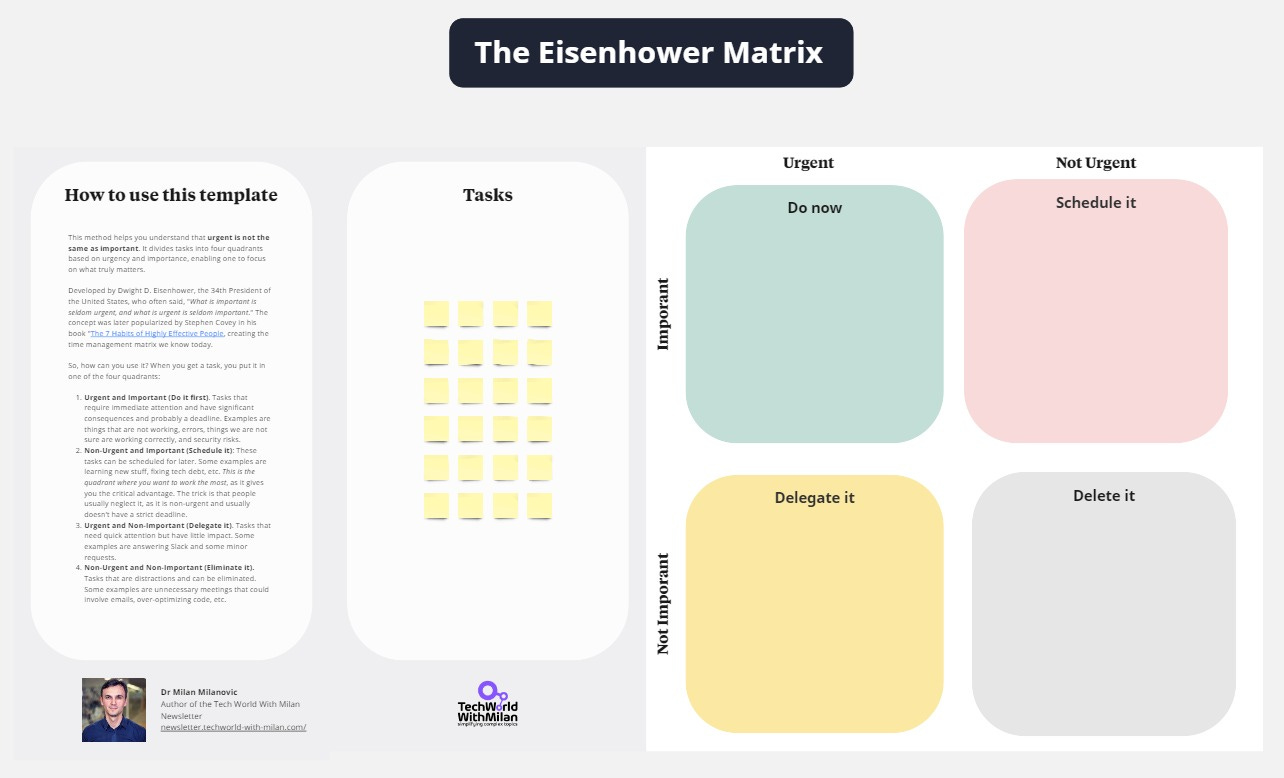
]( https://miro.com/miroverse/eisenhower-matrix-for-prioritization/)
1.2. 3-3-3 Rule #
This method, often used in productivity coaching, is designed to simplify your focus. Oliver Burkeman (best-selling author of Four Thousand Weeks) originally shared this technique in his newsletter. The first three hours of deep work distinguish this method from other productivity hacks. If you tackle them first, you’ll be more alert, concentrated, and capable of tackling a task without becoming sidetracked. Do not answer emails or texts, engage in small talk, or perform unimportant tasks during those three hours.
The method consists of these three groups of activities:
Three hours to work on the most critical tasks. Here, you can use the deep work technique to focus without interruptions and produce results. This will generate meaningful daily, weekly, and monthly progress.
Three shorter tasks, such as emails or meetings. This keeps your “doom pile” from getting too large.
Three maintenance activities, such as delegating or providing feedback. Outside work can also be focused on health, relationships, and more.
How you can use this method, for the following day in the evening, write down a 3-3-3 plan by asking the following questions:
What is the most important task you need to finish tomorrow? Dedicate 3h to it.
What are 3 small tasks you would like to complete?
What are those 3 maintenance activities you need to work on?
And then, during the day, when you finish, check those things as completed.
Advantages:
✅ It prevents overwhelming yourself with too many tasks
✅ Encourages focused work sessions
✅ Allows for regular breaks and reassessment
Best for: You have a long to-do list and struggle to get started or stay focused.
[
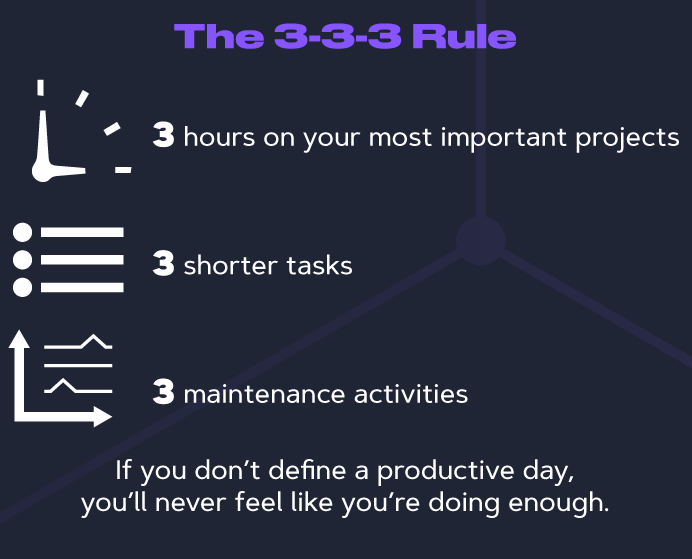
The 3-3-3 Rule
⚒️ Tools: You can clone my Notion template for the 3-3-3 Method.
[

]( https://milan-milanovic.notion.site/3-3-3-Method-2000080c1d304dcf8f873d5bfc93e3cf?pvs=4)
1.3. The Ivy Lee Method #
In 1918, Charles M. Schwab, president of the Bethlehem Steel Corporation, sought advice from Ivy Lee, a highly respected productivity consultant. Lee proposed a simple method, which proved so effective that Schwab reportedly paid Lee $25,000 (equivalent to about $400,000 today) for his advice.
Steps:
At the end of each work day, write down the 6 most important tasks you want to accomplish tomorrow.
Rank them in order of importance.
Focus only on the first task until it’s finished before moving on to the next one.
At the end of the next day, move any unfinished tasks to the next day’s list.
You should use it to improve productivity and ensure daily progress on critical projects.
🚩 One important thing here is that when you grab 6 tasks, you still need to know their priority, and for this, you can use the Eisenhower Matrix, so the 6 tasks could look like this:
[
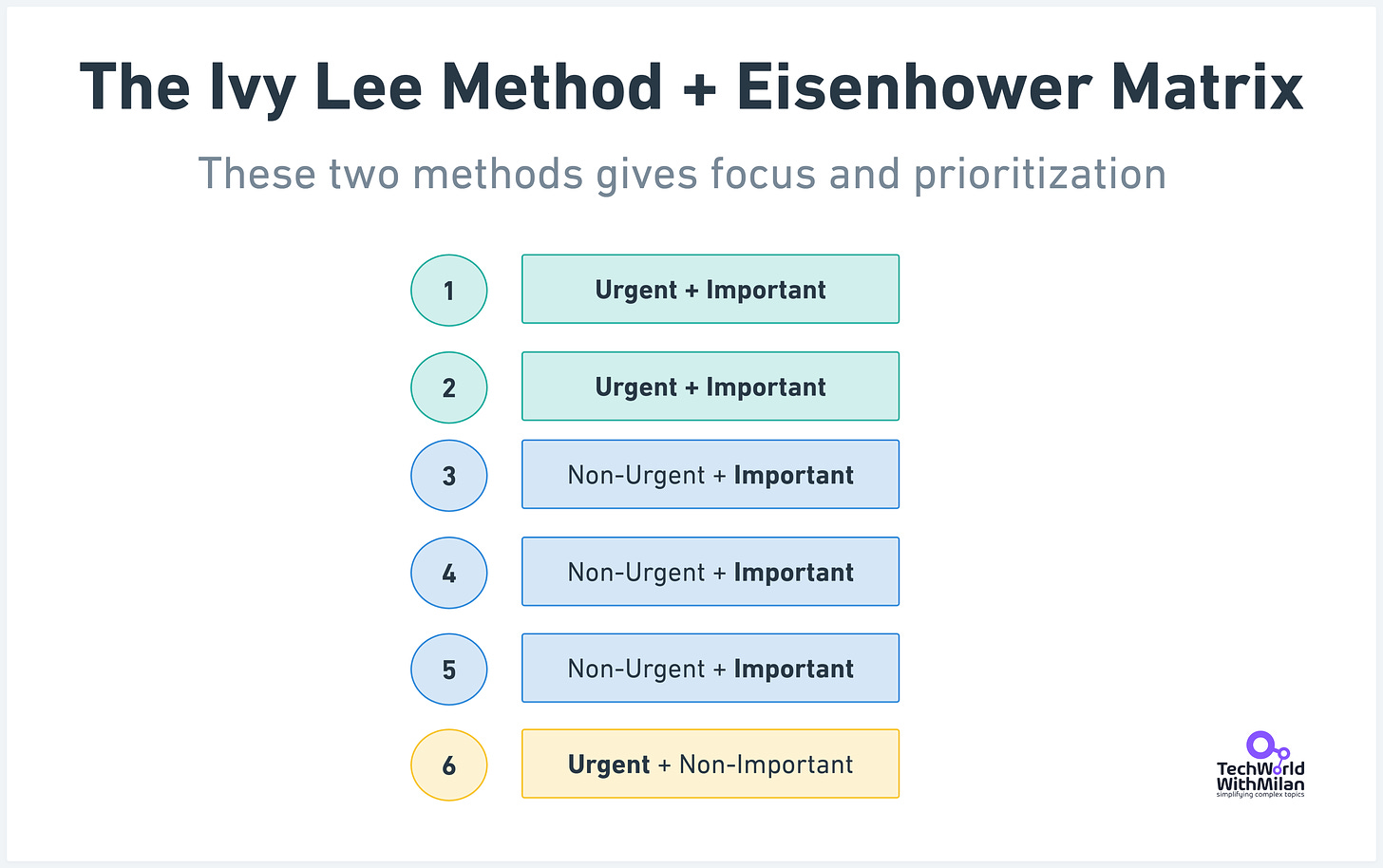
So, we want to include the most tasks from the Non-Urgent and Imporant quadrants here because they provide the most value. If you have too many urgent and important tasks, this is usually an indicator that you have planning issues and are constantly putting out fires.
You can also use this method in combination with the 3-3-3 method, in which you still work on 6 tasks, but they are prioritized differently now. We made a minor modification here, so you have only two maintenance activities, but it’s up to you to adjust.
[
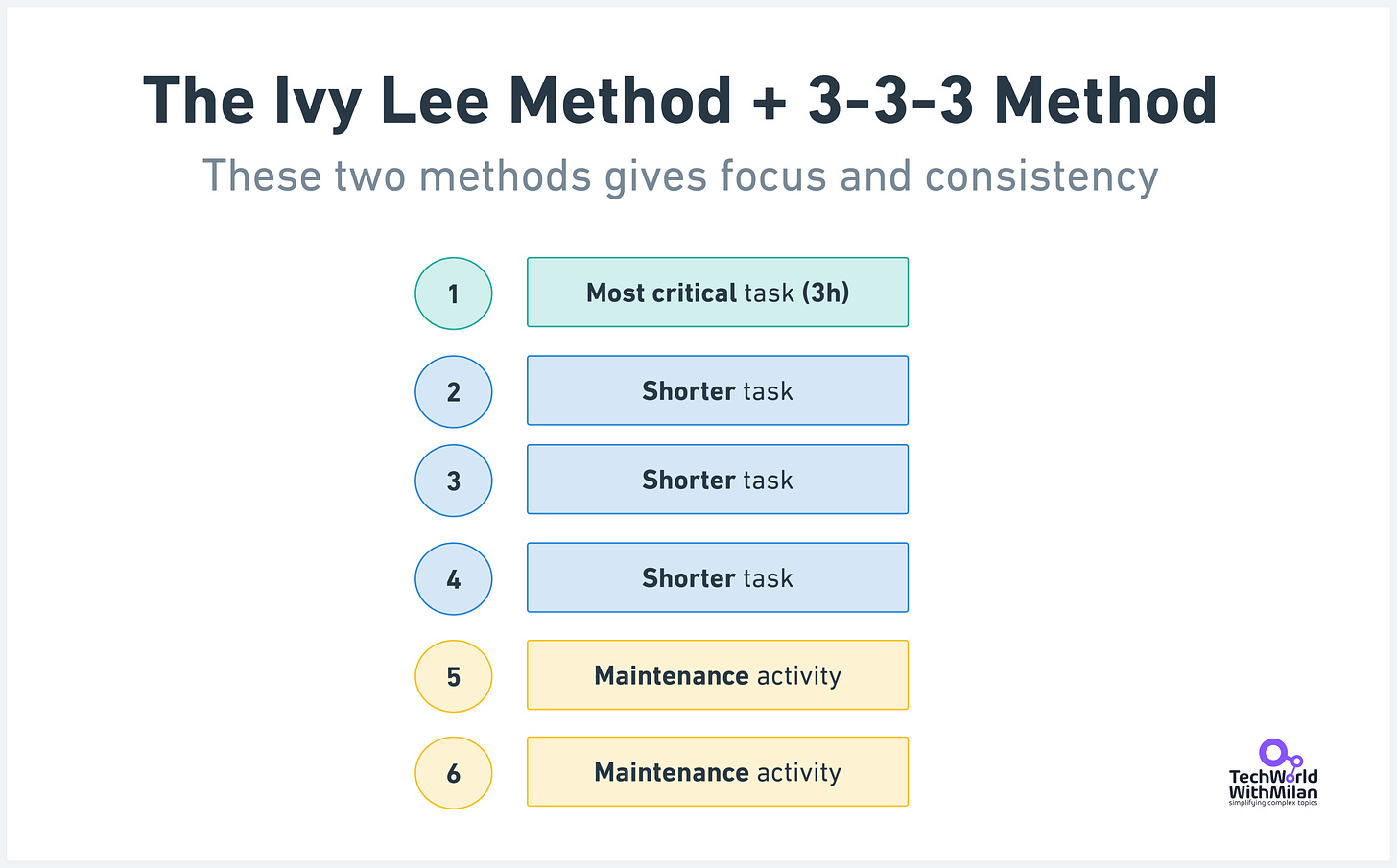
Why it’s effective:
✅ Encourages decision-making the night before, saving time in the morning
✅ Limits the number of tasks to a manageable amount
✅ Promotes focus on one task at a time
✅ Creates a habit of consistently working on important work
Best for: Establishing a consistent daily routine and tackling your most important work.
[

The Ivy Lee Method
2. For Leaders #
As a leader, you cannot use only methods for prioritizing personal tasks, as your impact is now much more significant; it spans teams or even the whole company. For such prioritization, you can use the following methods.
2.1. Pareto Principle #
The Pareto Principle is named after Italian economist Vilfredo Pareto, who observed 1896 that 80% of Italy’s land was owned by 20% of the population. This principle has since been applied to many fields, including business and productivity.
It is also known as the 80/20 rule, which states that 80% of results come from 20% of efforts. The Pareto Principle suggests that 80% of a company’s revenue comes from 20% of its customers, 20% of your reading produces 80% of your knowledge, etc. In time management, it implies that 20% of your activities account for 80% of your results.
The principle prioritizes the 20% of tasks that will have the most significant impact. It encourages focusing on the vital few rather than the trivial many.
How I used this method is to reflect on the following questions:
Focus on my top 20% most important customers. Engage with them, get the feedback, give them a reasonable offer, etc.
Solve the company’s biggest problems. Every company has many issues, but only some are important. How would you recognize them? Check your company strategy and goals. What topics can you see there? Also, you can ask your company leaders. I’m sure they know what the most significant struggles are.
Leaders can identify and focus on the key activities that generate the most significant outcomes, maximizing efficiency and productivity.
Benefits:
✅ Helps focus on high-impact areas
✅ Useful for resource allocation
✅ Applicable across various business functions (sales, customer service, etc.)
Best for: Strategic decision-making and resource allocation at a high level, with focusing on what really matters.
[
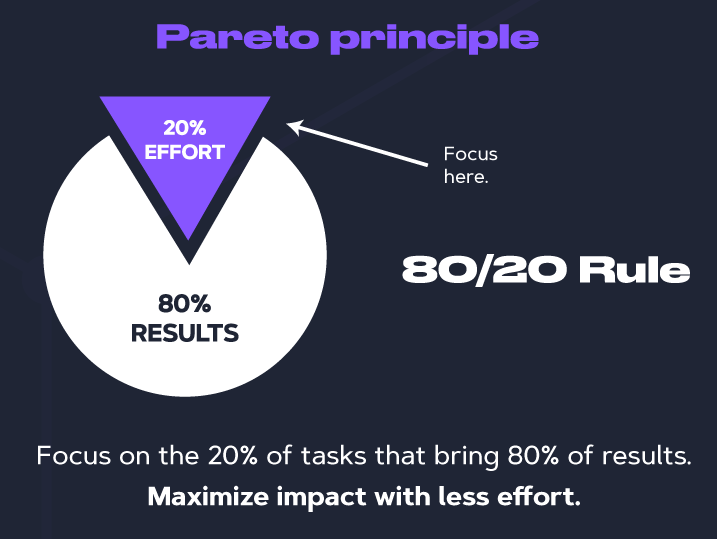
Pareto Principle
2.2. OKRs (Objective and Key Results) #
OKRs were first introduced by Andy Grove at Intel in the 1970s. The method was later popularized by John Doerr, who introduced it to Google in 1999. Since then, it has been adopted by many tech companies and other organizations.
It consists of:
Objectives are the goals you want to achieve, such as Improving our sales performance across the whole team or Improving our code quality.
Key results are the specific actions that must be taken to reach your objectives and must be quantitative. Preferably, we should use input and output results.
Input key results mean that we should have measurable things that you can control (consistently), e.g., fix 1 critical bug this week. In contrast, output key results suggest that the results for the inputs you can’t control are outcomes of your action, e.g., increase sprint velocity from 6 to 8 per person.
A good practice is picking three objectives and two key results for each. We should also set OKRs quarterly to track our performance against these metrics.
For example, one OKR for a Software Engineer role and their yearly plan for one quarter can look like this:
Objective: Improve our code quality
Key result 1: Fix 2 medium-level bugs this quarter
Key result 2: Increase code coverage to 85% on the project
Key result 3: Refactor 1 big area of code you did not initially create
Key result 4: Create and revise doc for each feature worked on this quarter.
This method best defines quarterly or annual company goals and yearly personal development plans and ensures department alignment.
📚 To learn more about it, read John Doer’s book “ Measure What Matters,” or Itamar Gilad’s “ OKRs Done Right.”
Advantages:
✅ Aligns individual and team goals with company objectives
✅ Encourages ambitious goal-setting
✅ Provides clear metrics for measuring progress
Best for: Setting and aligning goals across an entire organization.
[
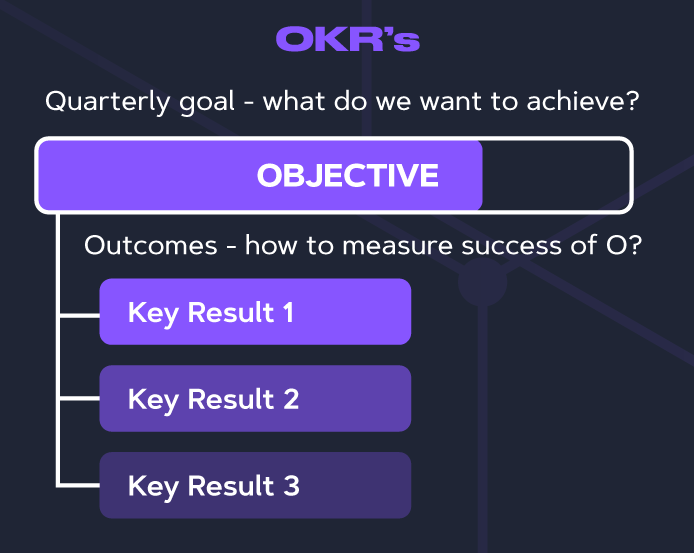
Objectives and Key Results
⚒️ Tools: Check my OKR template in Notion.
[
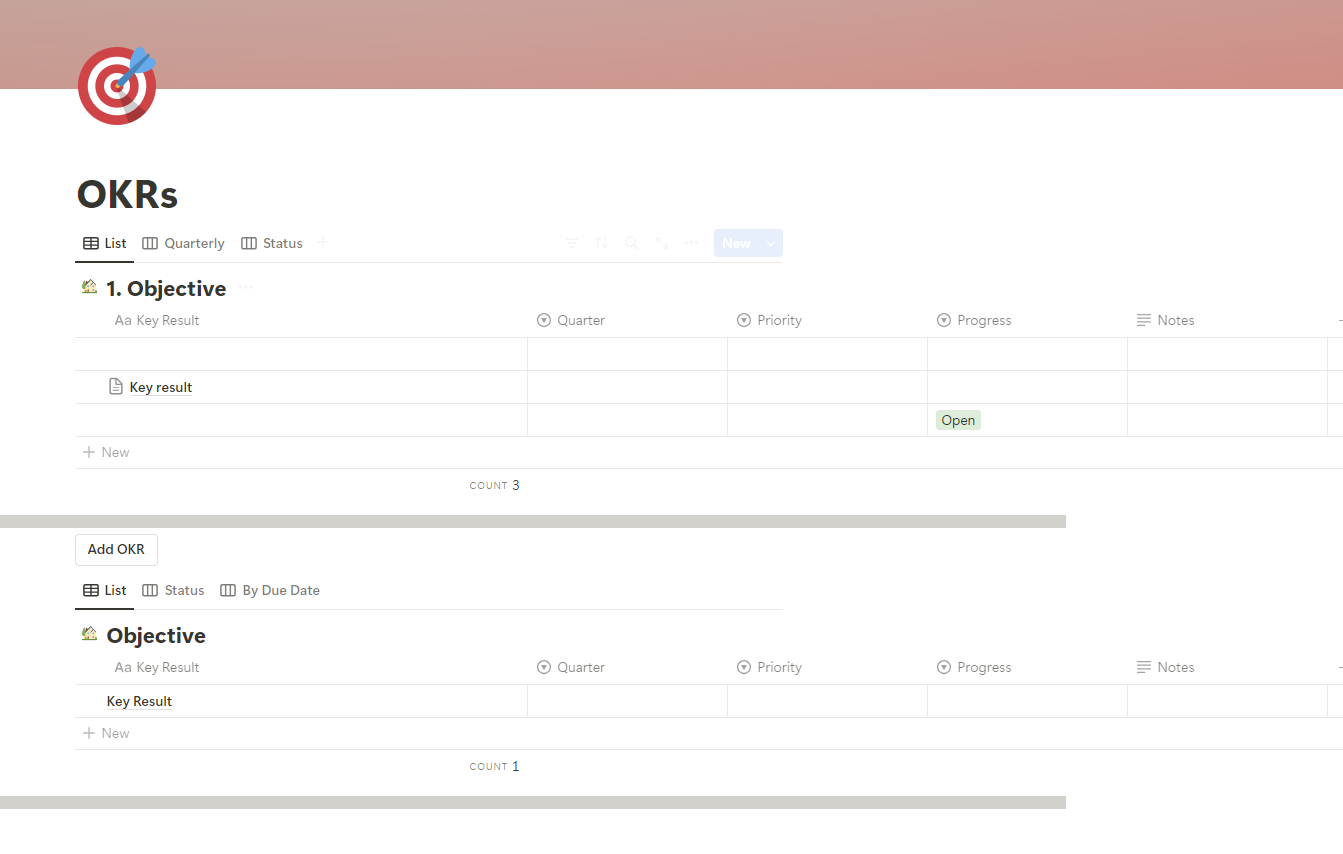
]( https://milan-milanovic.notion.site/OKRs-df1c7f034ed44ae3b9f385b993c634ed?pvs=4)
2.3. Warren Buffet’s 5/25 Rule #
This rule is attributed to billionaire investor Warren Buffett, though its origins are anecdotal. It’s said that Buffett once advised his pilot to use this method to help him focus on his career goals.
The rule is a simple two-step prioritization process:
Write down your top 25 goals in life
Circle your top 5 goals
The remaining 20 goals are your “avoid at all costs” list. The idea is to focus relentlessly on your top 5 priorities and avoid getting distracted by less important goals. Buffett argues that your “avoid at all costs” list is just as important as your top priorities. It forces you to make tough choices and say no to good opportunities that don’t align with your most important goals.
You should use this method when defining your organization’s core focus areas or planning your career trajectory.
Why it’s effective:
✅ Forces leaders to identify their most crucial priorities
✅ It helps eliminate distractions and less critical goals
✅ Encourages focus on long-term, high-impact objectives
Best for: Long-term strategic planning and personal career development.
[
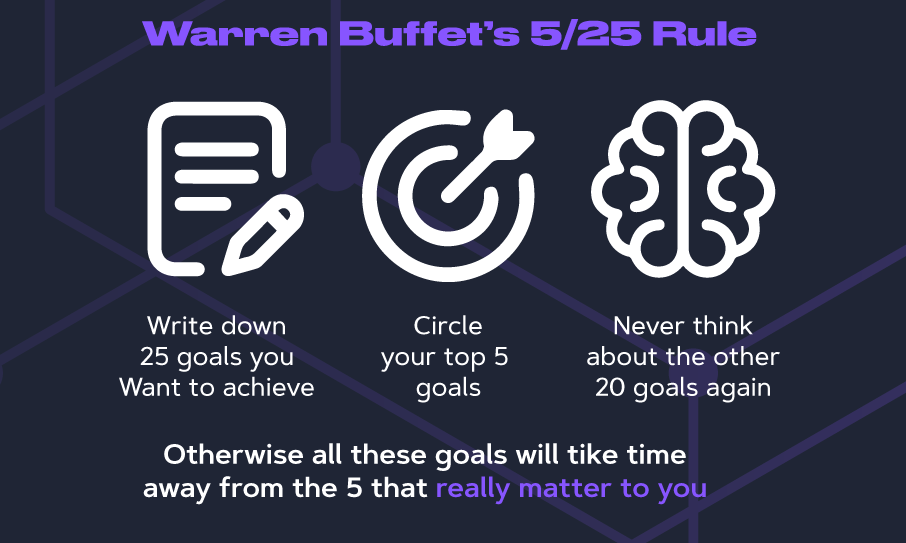
Warren Buffet’s 5/25 rule
3. For Teams #
When working in a team, prioritization becomes even more crucial to ensure everyone is aligned and working towards common goals. Here are three methods particularly suited for team prioritization:
3.1. ABCDE Method #
Productivity expert Brian Tracy popularized the ABCDE method in his book “ Eat That Frog!” It’s an expansion of the simpler ABC method, which has been used in various forms for decades in business and project management.
Teams rank tasks by assigning letters from A to E based on priority, where A is the highest priority, and E is the lowest. This helps ensure that the most critical tasks are addressed first, optimizing team productivity and effectiveness.
So, for each task, you assign a letter grade, such as:
A tasks - are the most important and must be done (high priority)
B tasks - are necessary but not as critical as A tasks (should be done)
C tasks - are nice to do but not necessary (have no consequences)
D tasks - can be delegated to someone else
E tasks - can be eliminated
The idea is to focus on completing your A tasks first before moving on to B tasks, and so on. It helps you avoid getting distracted by less important tasks.
For example, you can use it when planning sprints in software development.
Benefits:
✅ Provides a clear hierarchy of tasks and mind
✅ It helps identify tasks that can be delegated or eliminated
✅ Ensures the most critical work gets done first
Best for: Project teams with a large number of tasks that need clear prioritization.
[
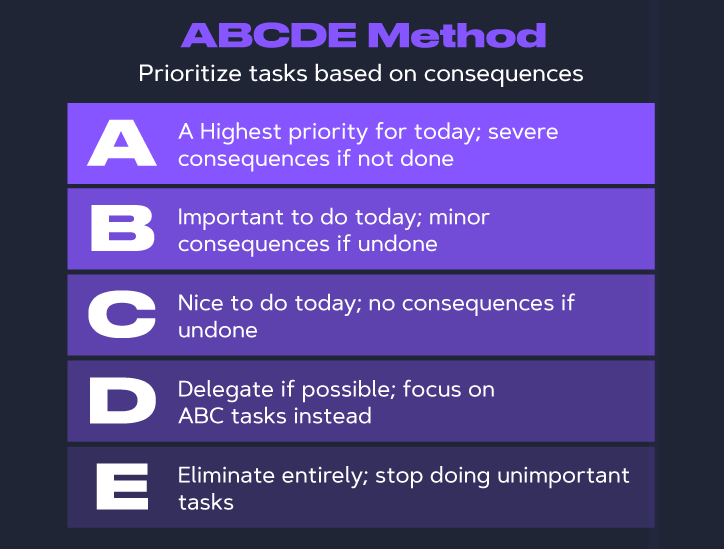
ABCDE Method
3.2. MoSCoW Method #
The MoSCoW method was developed by Dai Clegg in 1994 while working at Oracle. It has since become a popular prioritization technique in project management, particularly in Agile and software development environments.
The acronym stands for:
Must have - critical tasks that must be completed
Should have - important tasks that should be done if possible
Could have - tasks that are desirable but not necessary
Won’t have - tasks that will not be implemented in the current timeframe
By clearly defining the importance of each task, teams can manage their workload more effectively and ensure critical tasks are completed within time constraints.
We use this method to prioritize user stories in our Backlog.
Advantages:
✅ Helps teams reach a common understanding of priorities
✅ Helpful in managing stakeholder expectations
✅ Flexible enough to adapt to changing project needs
Best for: Projects with tight deadlines or limited resources where scope needs to be clearly defined.
[
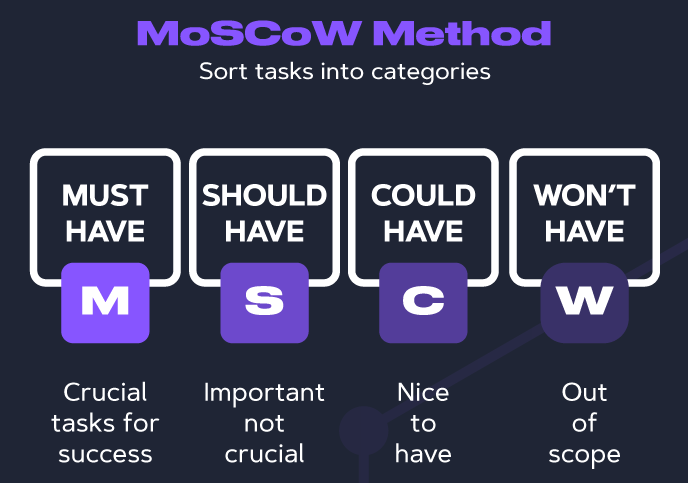
The MoSCoW Method
3.3. RICE Framework #
The RICE framework was developed by Intercom’s product team and introduced in a 2016 blog post. It aims to provide a more objective, data-driven approach to prioritization.
RICE is an acronym for the four factors used to evaluate each item:
Reach: How many people will this impact?
Impact: How much will it impact each person?
Confidence: How confident are we in our estimates?
Effort: How much time will it take?
Then, we can calculate the RICE score in the following way:
[

An example of the usage of this method could look like this:
[

RICE Framework example
This method can be used, for example, when deciding between multiple product features or marketing initiatives with various potential impacts.
Benefits:
✅ Provides a quantitative basis for decision-making
✅ It helps reduce bias in prioritization
✅ Allows for easy comparison between different initiatives
Best for: Data-driven teams that need to prioritize features or initiatives objectively.
[
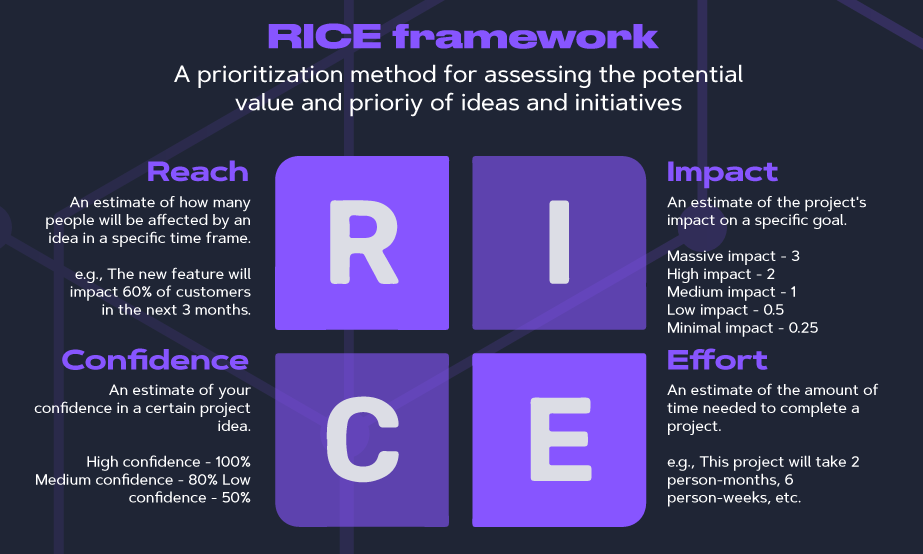
RICE Framework
⚒️ Tools: You can clone my Notion template for the RICE framework.
[

🛣️ How do you select the correct productivity method? #
Consider the timeframe: Methods like the 3-3-3 Rule might benefit short-term tasks, while long-term planning aligns better with OKRs or the 5/25 Rule.
Assess the complexity: Simple, individual tasks can use straightforward methods like the Ivy Lee Method, while complex team projects might require the RICE Framework.
Nature of tasks. If you have varying urgency and importance, then use the Eisenhower Matrix. If you need to distinguish between critical and non-critical tasks with more subtle differences, use the ABCDE method.
Consider your work style: Some prefer quantitative methods (like RICE), while others prefer more intuitive approaches (like the Eisenhower Matrix).
Evaluate the context: When selecting a method, consider your work environment, team dynamics, and organizational culture.
[
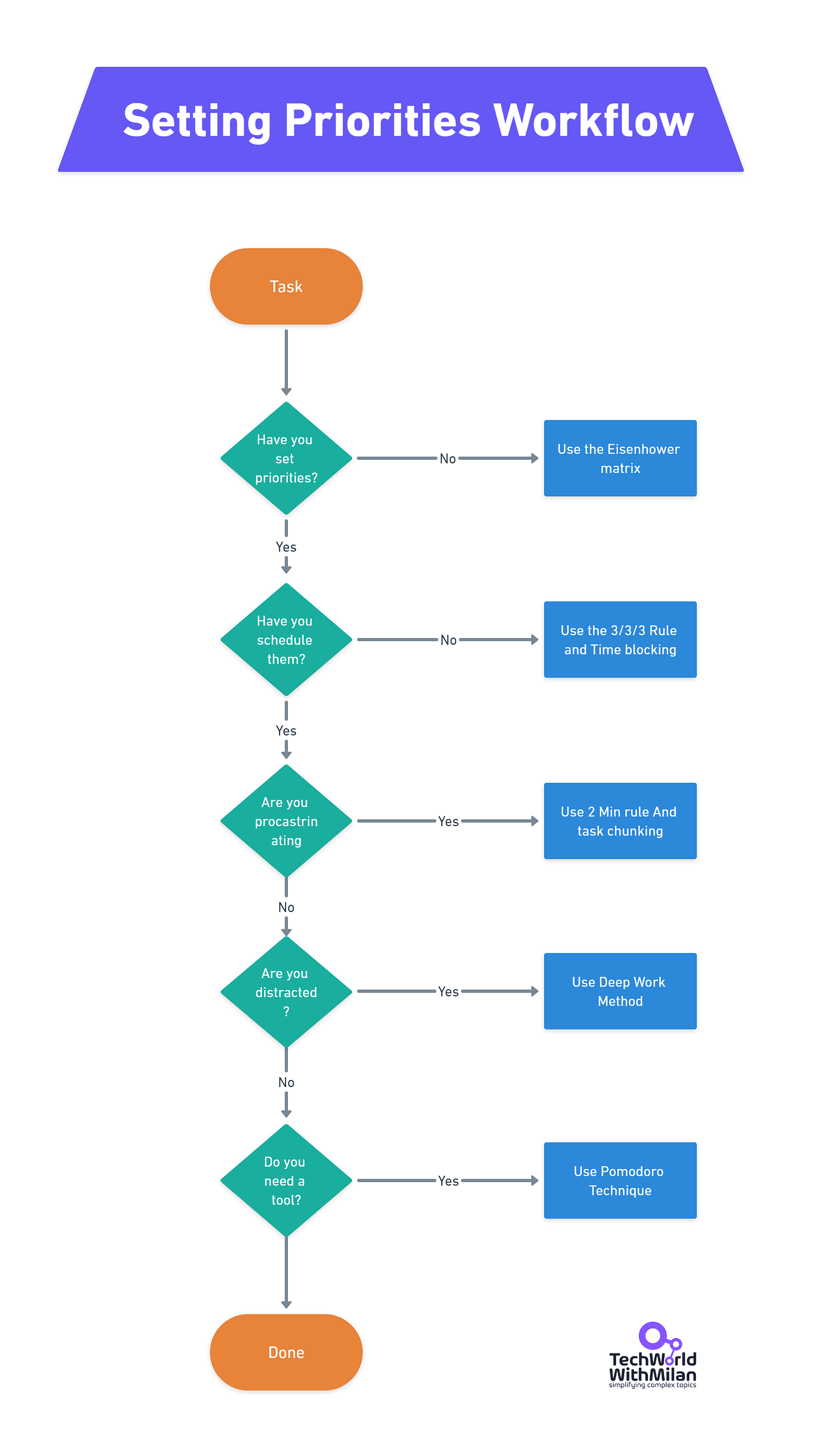
Remember, these methods are not mutually exclusive. You can often combine elements from different approaches to create a system that best suits your needs and situation.
Also, check some other methods for personal organization and productivity in my previous text:
🎯 Practical workflow for task prioritization #
Now that we know all essential prioritization and productivity methods, how can we use them together for personal productivity? The recommended flow that I use is the next one:
Capturing Tasks on a Master List. First, put all tasks on one list (called a master list), something like a brain dump. You can use the GTD method to manage this list. This list should be prioritized by monthly, weekly, and daily goals, where your monthly list pulls from your master list and the weekly list pulls from the monthly list.
Differentiating Urgent from Important Tasks with the Eisenhower Matrix. Then, you use the Eisenhower matrix to separate what is important and urgent. You can also use the Pareto principle (80/20 rule) to focus your efforts on 20%, which produces 80% results.
Ranking Tasks by True Priority with the Ivy Lee Method. Then, you use the Ivy Lee Method to rank your daily tasks according to your priority. This will give you six tasks (or less) to focus on (prioritize) every day.
Separating Tasks with Similar Priorities using the ABCDE Method. If you have tasks with similar priorities, the ABCDE method can help. This method allows you to differentiate the level of priority.
Starting the Day with the Most Important Task. When you prioritize your list, it is now time to “ eat the frog” 🐸 (as Brian Tracy called it), i.e., do the most important and challenging task first (MIT).
[
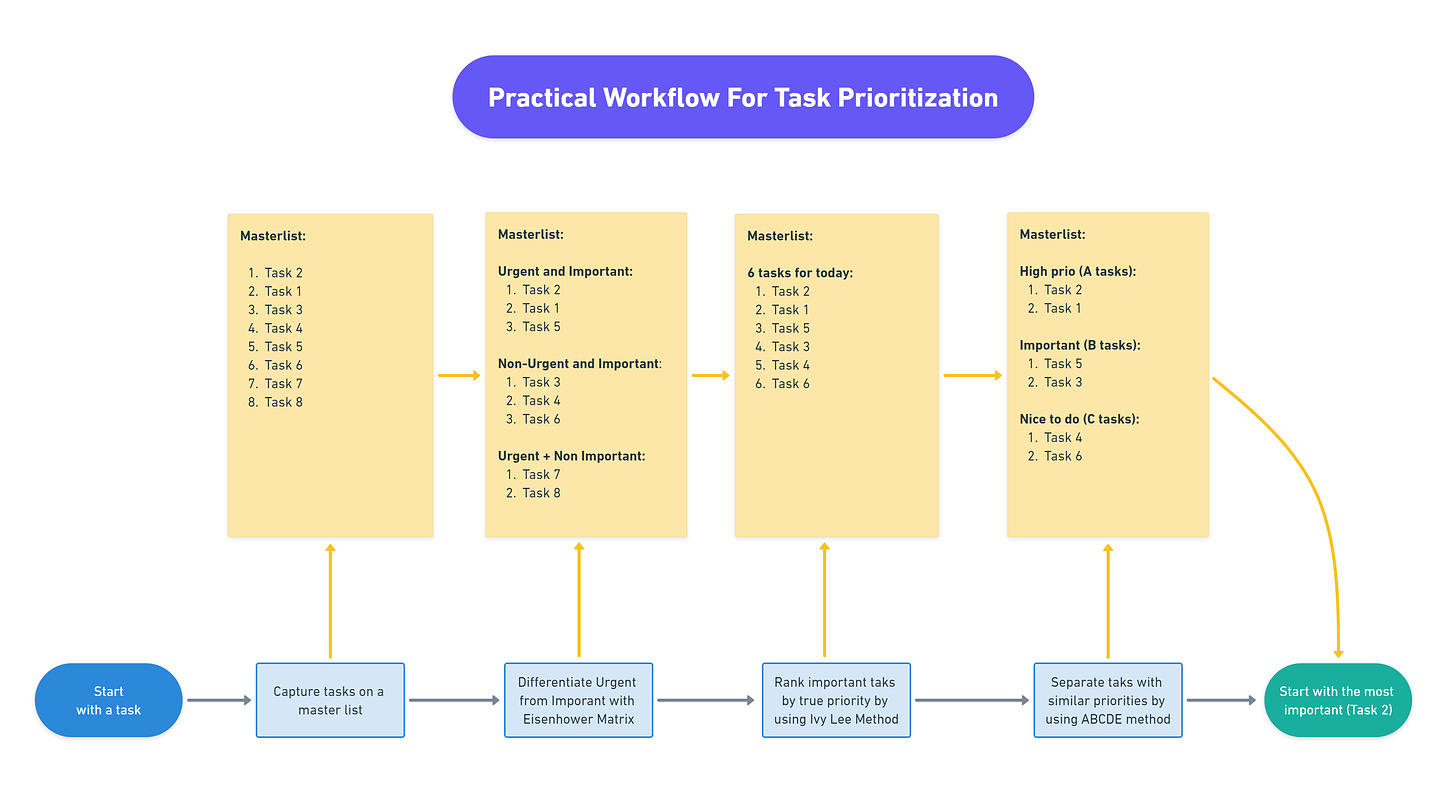
Practical Workflow for Task Prioritization
It is also important to note a few things here to be effective:
📅 Time-boxing #
Dividing your day into chunks or blocks is an effective plan. Everything goes to your calendar when you do this, and checking when you need to work on something is more manageable. You can use the visual timer with a time-blocked schedule as a reminder to stay on task (check ⚒️ the Llama Life tool).
Harvard Business Review ranks this method the #1 most effective productivity “hack” (of 1000 tested).
[
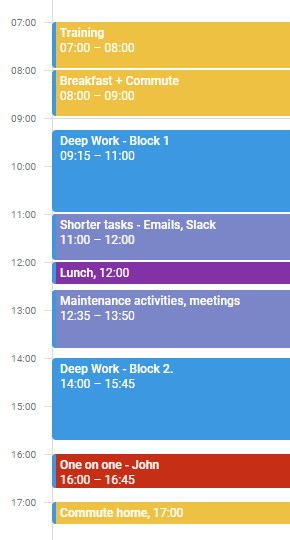
Time-blocking example with Deep Work
⏰ Sunk cost fallacy #
Be aware of the sunk cost fallacy effect. Even after doing all the prioritization, you still need to be flexible. Some things can change, and you don’t have an influence on some things, which is OK. But, we are compelled to continue doing something just because we have already put some effort into it. Yet, we cannot get time back, so spending more time there doesn’t make sense if the thing loses priority.
[
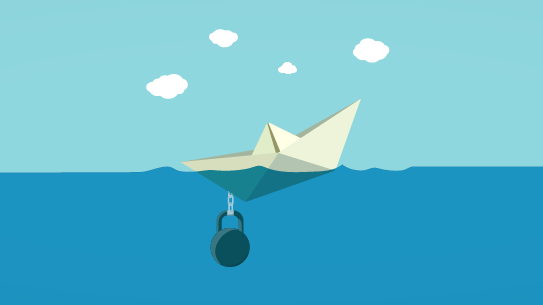
Sunk cost fallacy
🚀 Time multipliers #
This means using strategies and tools to create more time in the future. Prioritization is a one-time multiplier, but there are more:
Keep things simple. Eliminate all tasks that are unimportant to you or will not empower you to reach your goals.
Automate tasks. If you cannot remove tasks, try to automate them. You can use different tools, such as ⚒️ Zapier.
Delegate it. As leaders, we usually do things that can be delegated to others. When possible, try to delegate and offload your time to someone else.
Procrastinate. Do you need to do this today? Think twice about it, as sometimes we need to wait; half of the things will be resolved without our influence.
[

Time multipliers
🗲 Manage your energy, not time #
Every person has a time of day when they are most productive based on their chronotype. There are four chronotypes, which wake up naturally at 5 am, 6 am, 7 am and 8 am:
For the 5 am group, you’re the most productive 8-12 am.
For the 6 am group, it is 3 pm-7 pm.
For the 7 am group, it is 10 am-2 pm, and
For the 9 am group, it is 1 pm-5 pm.
It is recommended to identify your most productive hours when you feel the most energized and focused and then allocate them to important tasks where focus and creative thinking are required. Put off less taxing or repetitive duties for times when you’re naturally low on energy.
[
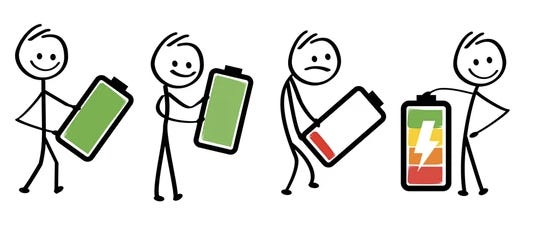
Check your energy levels
🗳️ Do you want to learn more about this topic? #
Would you be interested in a course on this topic by me? #
Not sure (write in the comments)
0%
POLL CLOSED
Bonus: Setting Priorities Cheat Sheet #
Here is the full productivity cheat sheet you can download and use:
[
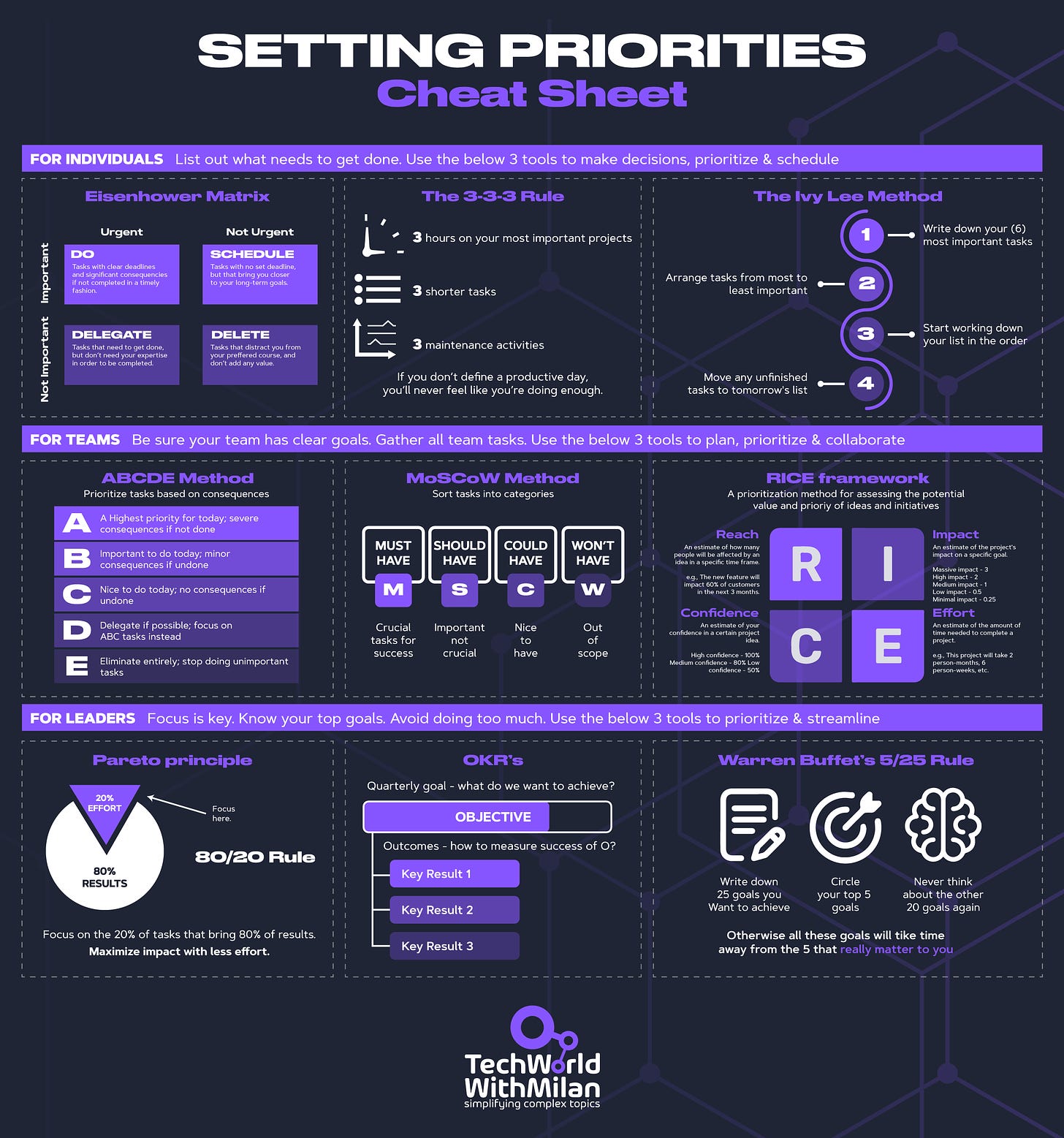
Setting Priorities Cheat Sheet
More ways I can help you #
Promote yourself to 33,000+ subscribers by sponsoring this newsletter. This newsletter puts you in front of an audience with many engineering leaders and senior engineers who influence tech decisions and purchases. My primary sponsorship slots are open again!
1:1 Coaching: Book a working session with me. 1:1 coaching is available for personal and organizational/team growth topics. I help you become a high-performing leader 🚀.